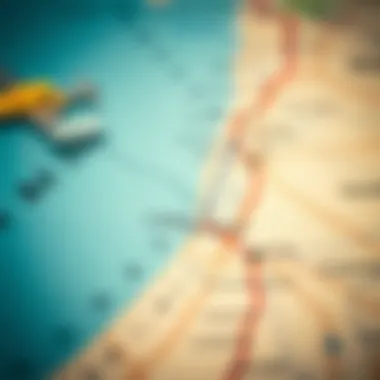Efficient Transfers Between Dubai and Abu Dhabi


Intro
Traveling between Dubai and Abu Dhabi can feel like going from one world to another, despite the relatively short distance separating these two bustling metropolises of the UAE. With their unique cultural experiences, attractions, and lifestyles, understanding the various options for transferring between these cities is essential for anyone looking to maximize their visit or exploit investment opportunities.
As anyone familiar with the UAE knows, both cities possess their own charm. Whether you're an investor scouting the best neighborhoods, a homeowner contemplating relocation, or a traveler merely passing through, making an informed decision about your transfer method is indispensable. In this article, we’ll explore the different transportation options available, the costs involved, and the time it takes to hop from one city to the other.
We'll dive into what to expect when you make the journey, from public buses to private taxis, and even ride-sharing services. Moreover, we'll break down key factors that might influence your choice, such as comfort, efficiency, and affordability. This comprehensive guide aims to equip every reader with the insights necessary to navigate transfers between these two vital urban centers efficiently.
Overview of Dubai and Abu Dhabi
This article aims to illuminate the relationship between Dubai and Abu Dhabi, two major cities in the UAE that, while distinct, share undeniable ties. Understanding their geographical context, cultural significance, and economic links is essential for anyone considering travel between these urban centers.
Geographical Context
Dubai and Abu Dhabi lie along the southern coast of the Persian Gulf in the United Arab Emirates. Dubai is known for its innovative architectural feats and rapid urbanization. It covers an area of roughly 4,114 square kilometers. On the other hand, Abu Dhabi, the largest emirate in the UAE, spans about 67,340 square kilometers, making it more spacious yet less densely populated than Dubai.
The distance between the two cities is approximately 140 kilometers, or about 87 miles. Given the flat terrain of the UAE, the drive between them presents a fairly straightforward path along Sheikh Zayed Road, making it an easy commute for business and tourism alike.
Cultural Significance
Culturally, Dubai and Abu Dhabi showcase a rich tapestry of Emirati heritage interwoven with modernity. Dubai is often viewed as the cosmopolitan jewel of the UAE, attracting a multicultural crowd, while Abu Dhabi holds the seat of government and is home to traditional Emirati values.
Visitors to Dubai tend to indulge in luxury shopping, exhibitions, and extravagant entertainment. In contrast, Abu Dhabi offers cultural institutions like the Louvre Abu Dhabi that reflect the emirate's commitment to art and education. These cultural differences influence not only the experiences enjoyed by visitors but also their travel decisions between the cities.
Economic Ties Between the Cities
Economically, the two cities are intertwined through trade and investment. Dubai's economy heavily relies on tourism and trade, acting as a global business hub. Meanwhile, Abu Dhabi is rich in oil and gas resources, with a more diversified economy that includes finance, real estate, and renewable energy. The two cities often collaborate on large-scale projects, but they also engage in friendly competition to attract investors.
The economic synergy supports the local job market and strengthens ties for expatriate communities who work in either emirate. For potential investors, understanding these dynamics is crucial as they consider opportunities in real estate or business ventures within the enchanting landscapes of Dubai and Abu Dhabi.
The connection between Dubai and Abu Dhabi is not just geographical; it encompasses cultural depth and economic insight, making travel between the two a key consideration for residents and tourists alike.
Traveling Between Dubai and Abu Dhabi
Traveling between Dubai and Abu Dhabi is a necessary consideration for residents and visitors alike, mainly due to the close proximity of these two major cities. With cultural richness, urban development, and economic opportunities, understanding the nuances of this travel can transform an everyday commute into a fruitful experience. Close to 140 kilometers apart, both cities boast different attractions, making the journey not just about reaching the destination but also about savoring the travel experience. Choosing the right transport method isn’t merely a matter of convenience; it can significantly affect expense, time management, and the overall enjoyment of the trip.
Modes of Transportation
Private Car
Using a private car is one of the most embraced options for traveling between Dubai and Abu Dhabi. This method grants unrivaled freedom, allowing travelers to dictate their journey. With the joy of personal space, one can enjoy the privacy and comfort of their own vehicle. It’s easy to slip out onto the road, enjoy the drive while engaging in conversation or music, or even enjoy spontaneous detours to points of interest that might not fit a packed itinerary. However, parking can sometimes become a bit of a hassle when reaching Dubai or Abu Dhabi, especially in busy areas.
Public Buses
Public buses present a budget-friendly option, especially for those conscious of their expenses while traveling. With frequent departures, these buses connect the two cities efficiently and are a perfect fit for those who appreciate a laid-back journey. One notable unique feature is the cleanliness and punctuality associated with the bus services. However, the trade-off often comes with longer travel times than a private vehicle. Nevertheless, this mode allows for a somewhat immersive experience, offering glimpses into the daily lives of locals via a shared space.
Taxi and Ride-Sharing Services
Taxis and ride-sharing services, such as Uber or Careem, provide a convenient middle ground between public transport and private vehicles. This option is particularly appealing for those who might not want to deal with the logistics of parking but still appreciate the flexibility of personal travel. Another great feature is the reliability of pickup and drop-off services, eliminating some of the stress of navigating the two city landscapes. Despite this, the cost can escalate quickly, especially during peak hours or with longer distances.


Intercity Train Services
While not as predominant as other methods, intercity train services are an emerging option gaining traction. Trains potentially shorten travel times and offer a comfortable setting, making it a favorable choice for both tourists and business travelers. The scenic views along the journey present a unique vantage point. However, this service might not be as widely available yet and can have sporadic schedules, necessitating careful planning ahead to ensure alignment with one’s timetable.
Driving Observations
Road Conditions
Understanding the road conditions is paramount when traveling between Dubai and Abu Dhabi. The highways connecting the two cities are generally well-maintained, characterized by modern infrastructure and broad lanes. In addition to being a smooth ride, the scenic landscapes add a touch of enjoyment. However, it is crucial to stay mindful of speed limits and various traffic regulations that can influence your overall driving experience.
Safety Regulations
Safety regulations in the UAE are stringent and enforced rigorously. Wearing seat belts is mandatory, and lapses in traffic rules can lead to hefty fines. The authorities place great emphasis on road safety, implementing strict penalties for reckless driving. This strict adherence ensures a safer driving experience for everyone, highlighting societal values about road safety.
Traffic Considerations
Traffic between Dubai and Abu Dhabi can vary significantly based on the time of day. During rush hours, the roads can see considerable congestion, particularly near urban centers. Yet, with a little foresight, travelers can time their journeys to avoid the brunt of traffic. While navigating the roads, it is essential to remain vigilant and aware, as other road users can sometimes display unpredictable behavior. Keeping these aspects in mind can help in planning a hassle-free travel experience.
Cost Implications of Transfers
Understanding the financial element of transferring between Dubai and Abu Dhabi is crucial for anyone considering the trip. With a swift increase in the number of residents and visitors shuttling between these two vibrant cities, the overall costs directly influence the choice of transportation and impact budgeting strategies. Knowing how to weigh these costs can help travelers make practical decisions that suit their time and preferences.
Comparative Analysis of Costs
Public Transport Costs
Public transportation represents one of the more economical methods for getting from Dubai to Abu Dhabi. With options like the Abu Dhabi link bus providing a connection to Dubai, the ticket prices are kept reasonably low. In fact, the fare often hovers around AED 25, making it a geographically savvy choice for travelers looking to pinch pennies. One standout characteristic is the frequency of service—they usually run every 30 minutes.
This accessibility is a significant advantage, especially for those who prioritize saving money over speed. However, it's important to note that this choice offers limited comfort and encloses travelers to a set schedule, which might not suit everyone.
Private Transportation Expenses
On the other hand, opting for private transportation, like a taxi or a hired car, gives you the freedom to traverse at your own pace. Yet, it comes with extra overhead. Starting fares for taxis can set you back around AED 70 from Dubai to Abu Dhabi, climbing as additional charges pile on depending on time and waiting periods.
A prominent feature here is privacy and comfort. Travelers appreciate the exclusive space, especially when transporting family or guests. However, the expenses can ramp up quickly, making this a less attractive option for budget-conscious individuals.
Hidden Costs
It’s crucial to recognize the hidden costs associated with travel between the two cities. While the ticket or fare might seem straightforward, various elements play into the total expenditures. For instance, bus services may not include additional fees for luggage or unforeseen surcharges for peak hours. Similarly, if using a private vehicle, fuel prices and potential tolls in the region add up.
A key takeaway is that understanding these hidden costs can present a more accurate picture of what the total journey may entail. This way, travelers can make informed choices by preparing their budget more accurately.
Budgeting for Travel
When planning a transfer, establishing a realistic budget represents a foundational element of the entire trip. Start with an outline of your transportation preferences while incorporating potential extra costs.
Setting aside a buffer—say, an extra AED 50-100—can help mitigate any unexpected expenses, be it an extended wait for a ride or last-minute tickets for public transport. Additional online resources will help project an accurate financial estimate, allowing for prudent decision-making throughout the journey. Travelers can consult www.visitabudhabi.ae or www.dubai.ae for current transport options and up-to-date costs.
Time Considerations
In the bustling world of Dubai and Abu Dhabi, time is often the central currency. Whether you're an expatriate heading to work or a tourist eager to soak up the sights, understanding the time it takes to travel between these two vibrant cities is essential. This section looks into the expected travel times, which can save you from unnecessary delays, and the dynamics of peak and off-peak traffic.


Expected Travel Times
Public Transport Timings
When it comes to public transport, the clock plays a crucial role. The intercity buses that connect Dubai and Abu Dhabi are usually well-scheduled, offering frequency and reliability to the commuter. Most bus services operate from early morning until late evening, which means you can reasonably plan your day according to their timings. The key characteristic of public transport timings is their predictability, making it a beneficial option for those who prefer sticking to schedules.
One unique feature of public transport is the bus lanes that often help in bypassing traffic, allowing for a smoother journey. However, it’s worth noting that travel times can vary, particularly during high traffic. On average, it takes about 1.5 to 2 hours to travel between the city centers using public buses. If you factor in waiting times, the total duration can stretch a bit longer, making it an okay choice for those who are not pressed for time. Regular updates through transport apps can help you check the schedules on the fly.
Driving Duration Variances
Driving from Dubai to Abu Dhabi is another kettle of fish. The time it takes can fluctuate significantly based on road conditions and traffic. Typically, on a clear day, the journey may take around 1 to 1.5 hours, but during peak hours, heavy traffic can stretch this to as much as 3 hours. The unique feature here is that, unlike public transport, your travel time hinges entirely on real-time traffic conditions, which can change from minute to minute.
Moreover, the flexibility of driving also carries its own set of pros and cons. You have the freedom to leave when you want and stop as you see fit, making it ideal for those who favor spontaneity. However, this comes at the cost of unpredictable delays, particularly if you are rambling along during rush hour. It's prudent to check traffic updates before hitting the road, ensuring that your choices align with your schedule.
Peak and Off-Peak Travel
Scheduling your transfers during off-peak hours can be a game-changer. With fewer cars on the road, the flow is smoother, and you might find your journey completed in a fraction of the time. Conversely, during rush hours, particularly Sunday mornings and Thursday evenings, traffic is known to be at its worst, which would mean packing a bit more patience into your bags. Choosing the right time to travel can make all the difference, both in terms of convenience and overall experience.
Logistical Factors
When traveling between Dubai and Abu Dhabi, understanding the logistical factors at play is essential. These elements dictate not just how smoothly your journey will go, but also the overall ease of transferring between these two bustling cities. The right preparation can save time and alleviate any potential inconveniences.
Essential Travel Documentation
Every travel journey requires some standard paperwork, and the trip between Dubai and Abu Dhabi is no different. While these two cities are within the same country, having the necessary travel documentation is crucial, especially if you plan to delve into any legal or formal business scenarios.
Visitors and residents should be aware of the following essential travel documentation:
- Passport: An up-to-date passport is required for all international visitors. Ensure it is valid for at least six months.
- UAE Visa: Depending on your nationality, a visa might be necessary, which can be arranged prior to arriving or upon entry.
- Driving License: If you wish to drive between the cities, having a valid driving license is a must. For expatriates, an international driving permit is often needed if your license is not in Arabic.
To avoid any delays, keep these documents handy and ensure they meet all the local and international regulations. The more prepared you are, the lesser the chances of running into bumps along the way.
Local Driving Regulations
For those opting to travel by car, familiarizing yourself with local driving regulations is important not just for legality, but also for safety. Driving in the UAE can be a wholly different experience compared to other countries.
Key points to consider regarding driving regulations include:
- Speed Limits: Speed limits are strictly enforced on highways and city roads. Generally, it’s 120 km/h on highways and can drop to 60-80 km/h in urban areas. Watch out for speed cameras.
- Road Signs: Most road signs are bilingual, featuring Arabic and English. However, always pay attention to local signage, as some areas have unique driving rules.
- Seat Belt Laws: Seat belts are mandatory for all passengers, and failure to comply can result in fines.
- Alcohol Limit: The UAE has a zero-tolerance policy regarding drinking and driving. Ensure you refrain completely from consuming any alcohol if you intend to drive.
Following these regulations not only ensures your safety but helps maintain the rule of law in the greater UAE area. Ignoring local driving laws can lead to hefty fines, or worse—accidents.
Understanding and adhering to local regulations can significantly enhance your travel experience while ensuring safety and legality.
In summary, the logistical factors involved in transferring between Dubai and Abu Dhabi can't be overlooked. Having your travel documents sorted, being equipped with knowledge about driving rules, and planning effectively will pave the way for a smooth travel experience.
Influences on Transfer Choices
Understanding the factors that influence transfer choices between Dubai and Abu Dhabi is vital for making informed transportation decisions. The unique landscapes of both cities create distinct motivations for travelers, impacting their preferred transportation methods. By pinpointing individual priorities, whether they lean toward business obligations or leisurely pursuits, one can navigate the bustling traffic between these two metropolises with greater clarity.
Purpose of Travel


Business vs. Leisure
When planning a transfer, the primary purpose of travel plays a significant role in determining the right mode of transport. Business travelers often seek efficiency and reliability, valuing punctuality above all. They may opt for a private car or shuttle service, as these options typically offer a more direct route and minimize delays. In contrast, leisure travelers might prioritize cost and experience, opting for public buses or rideshare services that can provide scenic views along the route.
A key characteristic of business travel is urgency, often leading individuals to choose modes of transport that ensure they arrive on time. Conversely, leisure travelers may enjoy the journey itself, resulting in a more relaxed approach to travel choices. This distinction is significant, as each purpose shapes travelers' expectations and ultimately affects their decisions.
One unique feature of business trips is the potential for corporate subsidies to cover transport costs, making private options more viable. However, leisure trips typically involve tighter budgets, where affordability becomes paramount.
Residency Determinants
Residency status can heavily influence transportation decisions as well. For residents of either Dubai or Abu Dhabi, familiarity with local transport systems may lead to preferences that differ greatly from visitors. Residents may lean towards driving their own vehicles, taking advantage of knowledge of traffic patterns and shortcuts. On the other hand, tourists or expatriates might rely heavily on taxis or buses, often unsure about local road rules and navigation.
A key characteristic here is the distinction between familiarity and novelty; residents are comfortable with their environment and logistics, while visitors could feel overwhelmed by the bustling urban setup.
Unique features of residency can also affect costs and conveniences. Residents may find private vehicle usage more economical in the long term but might have to deal with the drawbacks of maintenance and fuel. For newcomers, opting for reliable taxis can ease anxiety tied to getting lost or understanding route changes, albeit at a higher price point.
Personal Preferences
Comfort vs. Cost
Another layer to consider revolves around personal preferences, specifically comfort versus cost. Individuals may have different thresholds for what they consider acceptable regarding travel experiences. Some travelers prioritize comfort and opt for high-end shuttles or private cars, valuing the quiet and relaxation that such modes provide. Others may choose budget buses or shared rides, emphasizing savings and viewing the travel as part of their adventure.
The key characteristic of this choice is the balance people strike between financial constraints and their desire for a pleasant journey. For those with deeper pockets, the comfort of a premium service outweighs any budget concerns. Yet, for cost-conscious travelers, sacrificing a bit of comfort for cheaper options is often a common practice.
The unique feature of this dynamic is that it reveals more about the traveler’s lifestyle and preferences, whether they seek luxury or adventure in each segment of their journey.
Speed vs. Convenience
Lastly, the trade-off between speed and convenience deserves attention. Time-crunched business personnel often opt for the quickest modes available, even if they may incur higher costs. In contrast, leisure travelers frequently have more flexibility and therefore might prioritize convenience over speed, choosing options that allow for seamless transitions between activities and sightseeing.
A key characteristic of this aspect is that while speed appeals to those with rigid schedules, convenience caters to those with wanderlust and a desire to explore. The former may depend on express services or direct taxis, while the latter might appreciate buses that allow for stops at various landmarks along the way.
Ultimately, each factor loops back to the core objective of making transfers between Dubai and Abu Dhabi not just finite journeys but reflections of the individual’s needs and desires. Understanding these influences arms travelers with the knowledge needed to select the best transportation that aligns with their personal objectives.
Ending
The conclusion is a vital aspect of this article, neatly tying together the information presented on navigating transfers between Dubai and Abu Dhabi. By synthesizing key insights and actionable recommendations, this section serves to reinforce the reader's understanding of the complexities involved in making efficient travel choices between these two significant cities.
Recap of Key Insights
Throughout the article, we examined the multitude of factors influencing transfers, including various modes of transportation, associated costs, and the importance of timing. We discussed the practical elements such as:
- Modes of Transportation: Each option brings unique benefits and drawbacks, whether it's the comfort of private cars or the cost-effectiveness of public buses.
- Cost Considerations: Understanding the financial implications can greatly influence your choice. This was reflected in our analysis of both public transport fares and private transportation expenses.
- Time and Scheduling: Knowledge of peak travel periods versus off-peak times allows travelers to better manage their schedules and minimize delays.
This recap has highlighted that both residents and visitors can benefit from a well-rounded understanding of these dynamics, empowering them to make choices that align with their specific needs and preferences.
Final Recommendations
As you plan your next journey between Dubai and Abu Dhabi, consider the following recommendations:
- Assess Your Travel Purpose: Depending on whether the trip is for business or leisure, your requirements will vary significantly. Understanding your motive can guide you toward the most suitable transportation option.
- Budget Wisely: Always do a little homework on current transport fares, keeping in mind potential hidden costs like tolls or booking fees.
- Timing Is Key: Opt to travel during off-peak hours to ensure a smoother ride with less congestion.
- Stay Informed: Keep updated on local regulations or any city-specific advisories. This can often sidestep unexpected hurdles.
- Comfort vs. Cost: Weigh the pros and cons of comfort versus expenditure, especially if traveling with family or group of friends.
When traveling between Dubai and Abu Dhabi, being well-informed makes all the difference. Use the insights from this comprehensive analysis to your advantage, and enjoy a seamless journey between these iconic cities.
Your travels can shape your experience in profound ways. Make every transfer count.
For more detailed information, feel free to explore these resources: Wikipedia on UAE, Britannica, Visit Dubai, Visit Abu Dhabi.







